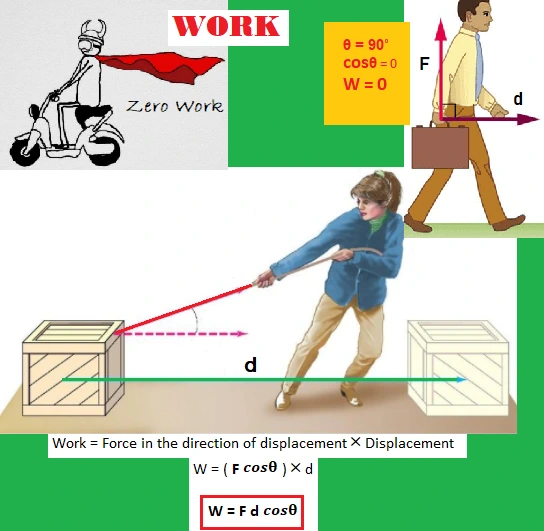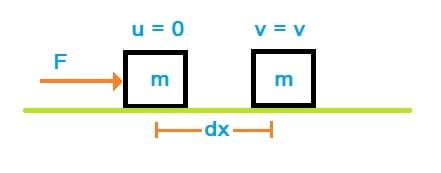Work Energy and Power notes
Work
Work is said to be done if force is applied to a body and it displaces in the direction of applied force.
Work is a scalar quantity as it have magnitude only.
Work done by constant force:
Work done (W) by a constant force (F) after displacing a body to a distance ‘d’-
W = F d cosθ
Where θ is the angle between force and displacement.
Unit of work:
SI unit of work is joule (J).
CGS unit of work is erg.
1 J = 10⁷ erg
Types of Work:
(1) Positive work
(2) Negative work
(3) Zero work
Table of Contents
(1) Positive work:
If Force and displacement both are in same direction positive work is done.

In the above example, a constant force ‘F’ is applied to a brick kept on a smooth horizontal table. The brick is displaced to a distance ‘d’ in the direction of the applied force . The work done by the applied force will be
W = F d cosθ
Here, the angle between the applied force and displacement is θ = 0˚, as both are in the same direction. So, cosθ = cos0˚ = 1
W = F d
Work = Force × Displacement

(2) Negative work:
If Force and displacement both are in opposite direction negative work is done.
- Example of negative work-
- Work done by frictional force is always negative.
- Work done by gravitational force while upward journey of body is negative.
(3) Zero work:
If Force and displacement both are perpendicular to each other there is no work or zero work.

Work done by variable force:

Energy
The ability to do work is called energy.
Energy is a fundamental concept that permeates every aspect of our lives. From powering our homes to fueling technological advancements, energy plays a vital role in shaping our world.
Energy is a scalar quantity.
Unit of Energy:
The SI unit of energy is called joules (J).
Types of energy:
- (1) Mechanical energy
- Kinetic energy
- Potential energy
- (2) Thermal energy
- (3) Chemical energy
- (4) Solar energy
- (5) Nuclear energy
(1) Mechanical energy
(i) Kinetic Energy
The energy possessed by a body due to its motion is called kinetic energy. For example, a moving car, flowing water, or a spinning turbine possess kinetic energy.
Expression for kinetic energy,
K = 1/2 mv2
- Kinetic energy (K) of a body depends on,
- mass of the body ( K ∝ m )
- speed of body ( K ∝ v2 )
Derivation of expression for Kinetic Energy:
Let’s consider an object of mass m initially at rest (u = 0). When F force is applied in it, object moves with velocity v. The work done on the object over in moving it to small distance dx in short interval of time interval dt is given by:


since, F and dx both are in same direction,

Now, force can be expressed using Newton’s second law as:
F = m a = m * dv/dt
Substituting this into the equation for work:
dW = F dx = m * dv/dt * dx
Rearranging the terms:
dW = m * dx/dt * dv
Since ds/dt is equal to the velocity (v), we have:
dW = m * v * dv
Integrating both sides of the equation over the entire motion from an initial velocity u to a final velocity v:


Since, work done is equal to the change in kinetic energy (ΔK). Therefore,

This expression relates the change in kinetic energy to the initial and final velocities of the object. In the case where the object starts from rest (u = 0), the expression simplifies to:
K = 1/2 m v²
This is the familiar expression for kinetic energy, showing that the kinetic energy of an object is proportional to the square of its velocity.
(ii) Potential Energy
The energy possessed by a body due to its position or change in shape and size is called potential energy. For example, An object on a hill, a compressed spring, and a charged battery all possess potential energy. Potential energy is of three types,
(i) Gravitational potential energy
(ii) Elastic potential energy
(iii) Electrostatic Potential energy
(i) Gravitational potential energy:
The energy possessed by a body due to its altitude above ground level is called Gravitational potential energy.
(ii) Elastic potential energy
The energy possessed by a body due to change in its shape is called Elastic potential energy.
(iii) Electrostatic Potential energy
The energy possessed by a charged body due to its position or configuration relative to other charged objects is called electrostatic potential energy.”
(2) Thermal Energy
The energy possessed by the body due to its temperature or heat. It is associated with the internal motion of particles within a substance.
(3) Chemical Energy
the energy associated with chemical bonds between atoms and molecules. Chemical Energy is released during chemical reactions, such as combustion or metabolism.
MY YouTube Channel Link : 👉🖱 https://www.youtube.com/channel/UCGpC7nWE0-bBv9I53MM8
Work Energy and Power, Work Energy and Power, Work Energy and Power, Work Energy and Power, Work Energy and Power, Work Energy and Power, Work Energy and Power, Work Energy and Power, Work Energy and Power